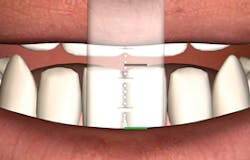Readdressing EFS
By Joseph J. Massad, DDS
Welcome back! The 2013 article that I received the most calls and emails about was "Identifying EFS from the outset." I discussed a device to measure the esthetic functional space (EFS) on the edentulous patient, which was defined as the space between the facial draping (lip coverage) in reference to the edentulous alveolar ridge crests.
The EFS is a vital factor in determining both esthetics and the positioning of implants prior to designing any specific full-mouth prosthetic appliance. If this space does not meet certain space guidelines, then the final prostheses will be compromised. Determining the EFS prior to prosthetic fabrication allows the practitioner to offer patients options such as pre-prosthetic surgery to create the required space for the prosthesis to occupy and to be both esthetic and functional. The determination of the need for pre-prosthetic surgery may narrow patient options on bar designs, stud type abutments, fixed dentures, or implant fixed bridge restorations.
The many questions I received from dentists after they read this article related to using the same ruler for immediate dentures and immediate implant overdentures. The answer was that this ruler would not be feasible for dentate patients. After hundreds of inquiries, a new ruler for the dentate patient was developed to allow practitioners to measure EFS for patients who still had some or all of their natural dentition. The new dentate ruler dictated the renaming of the ruler to Dentate Esthetic Functional Space Ruler (DEFSR), and renamed the EFS ruler to Edentulous Esthetic Functional Space Ruler (EEFSR).
The dentate ruler measures the vertical distance from the undisplaced vestibule to the incisal edges of the maxillary and mandibular teeth and its relationship to the lip at repose and/or smiling. The amount of tooth exposed below and above the upper and lower teeth in contrast to the facial drape at rest and smiling provides the visible reference in planning the final prosthetic restoration.
To assure accuracy, the DEFS ruler is only 0.5 mm thick to prevent a false recording by pushing the lip forward and distorting the natural position of the facial drape. The figure in this article shows that the mandibular teeth are significantly above the facial drape, creating both a nonesthetic and nonfunctional prosthesis if not considering both tooth and bone reduction before implant prosthetics. This new ruler has been the best communication tool for my patients and prosthetic lab. (Nobilium, Albany, New York)
The simplicity of these two rulers allows the practitioner the ability to diagnose the edentulous and dentate maxillary and mandibular esthetic functional space at the time of examination. This also allows the practitioner to discuss with the patient appropriate options or limitations, which improves communication about the overall treatment options.
I hope this tip will help you as it has helped me over my career. To view the full video step-by-step version, go to www.nobilium.com.
See you next month. I hope my pleasure in dentistry will also be yours.
Dr. Joseph Massad may be reached at 918-749-5600 or [email protected].
To see Dr. Massad's video tips, visit www.DentalLibrary.com
Past DE Issues

